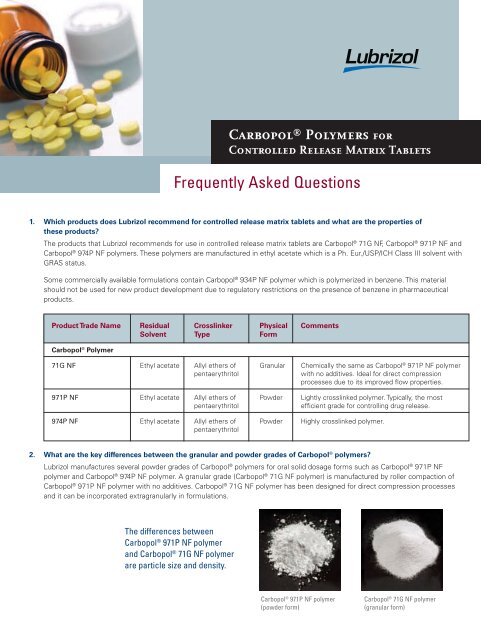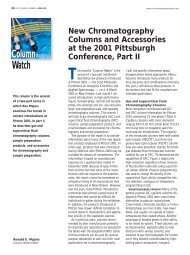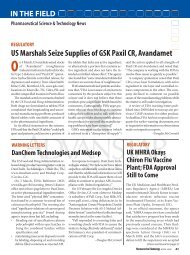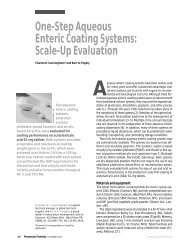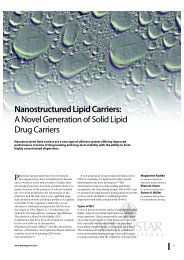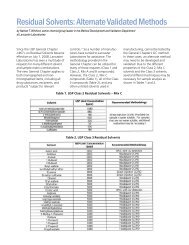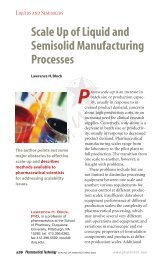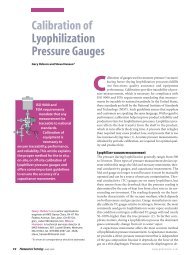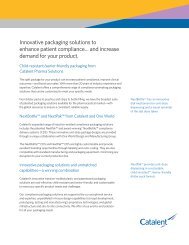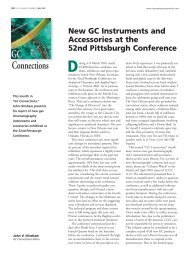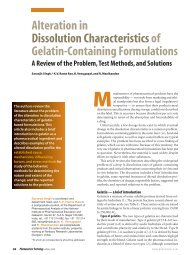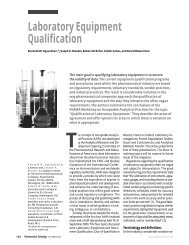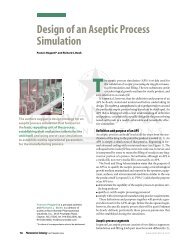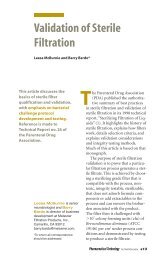Frequently Asked Questions - Pharmaceutical Technology
Frequently Asked Questions - Pharmaceutical Technology
Frequently Asked Questions - Pharmaceutical Technology
Create successful ePaper yourself
Turn your PDF publications into a flip-book with our unique Google optimized e-Paper software.
Carbopol ® Polymers for<br />
Controlled Release Matrix Tablets<br />
<strong>Frequently</strong> <strong>Asked</strong> <strong>Questions</strong><br />
1. Which products does Lubrizol recommend for controlled release matrix tablets and what are the properties of<br />
these products?<br />
The products that Lubrizol recommends for use in controlled release matrix tablets are Carbopol ® 71G NF, Carbopol ® 971P NF and<br />
Carbopol ® 974P NF polymers. These polymers are manufactured in ethyl acetate which is a Ph. Eur./USP/ICH Class III solvent with<br />
GRAS status.<br />
Some commercially available formulations contain Carbopol ® 934P NF polymer which is polymerized in benzene. This material<br />
should not be used for new product development due to regulatory restrictions on the presence of benzene in pharmaceutical<br />
products.<br />
Product Trade Name Residual Crosslinker Physical Comments<br />
Solvent Type Form<br />
Carbopol ® Polymer<br />
71G NF Ethyl acetate Allyl ethers of Granular Chemically the same as Carbopol ® 971P NF polymer<br />
pentaerythritol<br />
with no additives. Ideal for direct compression<br />
processes due to its improved flow properties.<br />
971P NF Ethyl acetate Allyl ethers of Powder Lightly crosslinked polymer. Typically, the most<br />
pentaerythritol<br />
efficient grade for controlling drug release.<br />
974P NF Ethyl acetate Allyl ethers of Powder Highly crosslinked polymer.<br />
pentaerythritol<br />
2. What are the key differences between the granular and powder grades of Carbopol ® polymers?<br />
Lubrizol manufactures several powder grades of Carbopol ® polymers for oral solid dosage forms such as Carbopol ® 971P NF<br />
polymer and Carbopol ® 974P NF polymer. A granular grade (Carbopol ® 71G NF polymer) is manufactured by roller compaction of<br />
Carbopol ® 971P NF polymer with no additives. Carbopol ® 71G NF polymer has been designed for direct compression processes<br />
and it can be incorporated extragranularly in formulations.<br />
The differences between<br />
Carbopol ® 971P NF polymer<br />
and Carbopol ® 71G NF polymer<br />
are particle size and density.
2 <strong>Frequently</strong> <strong>Asked</strong> <strong>Questions</strong><br />
3. What are the main benefits of using Carbopol ® polymers in controlled release matrix tablets?<br />
The main benefits of using Carbopol ® polymers in controlled release matrix tablets are as follows:<br />
• Highly efficient at low polymer levels (typical use levels are 3 – 30%), enabling smaller tablet sizes and overall formulation<br />
cost savings.<br />
• Provides flexibility in achieving a target release profile by varying the polymer level in the formulation. Compared to<br />
cellulosic materials, the drug release profile from a Carbopol ® polymer matrix can be more easily modulated by changing the<br />
polymer level.<br />
• Provides good binding characteristics, thus allowing formulation of matrix tablets without the addition of a tablet binder.<br />
• Synthetic, reproducible polymer.<br />
• Provides bioadhesive properties.<br />
• Enables development of patentable technologies for product differentiation and/or life cycle extension.<br />
4. What is the difference between the designation “Carbopol ® ” polymer and “Carbomer”?<br />
Carbopol ® polymer is a product brand name of The Lubrizol Corporation. There are a variety of Carbopol ® polymer grades which<br />
differ in their performance characteristics. These grades are distinguished by a number designation following the product brand<br />
name (e.g. Carbopol ® 971P NF polymer and Carbopol ® 71G NF polymer).<br />
In contrast, “Carbomer” is one of the generic names that can be used to describe Carbopol ® polymers. Carbomer can be defined<br />
as a high molecular weight polymer of acrylic acid crosslinked with allyl ethers of polyalcohols. The United States Pharmacopeia<br />
(USP) and European Pharmacopeia (Ph. Eur.) include various carbomer monographs.<br />
5. What is the current compendial nomenclature that applies to Carbopol ® polymers?<br />
The European Pharmacopeia has only one monograph which applies to Carbopol ® polymers called “Carbomers”. Similarly, the<br />
Japanese <strong>Pharmaceutical</strong> Excipients also has a single monograph called “Carboxyvinyl Polymer”.<br />
The United States Pharmacopeia/National Formulary has several monographs for different carbomer grades. The monographs<br />
called “Carbomer XXX” (where XXX is a numerical designation) are assigned to products manufactured with the use of benzene.<br />
Additionally, there are three umbrella monographs that separate carbomer products based on polymer structure. These three<br />
monographs are “Carbomer Copolymer”, “Carbomer Homopolymer” and “Carbomer Interpolymer” and they apply to products<br />
not polymerized in benzene. The differentiation within each umbrella monograph is based on viscosity characteristics (Type A,<br />
Type B and Type C).<br />
Lubrizol Polymers for Oral Applications<br />
Pharmacopeia Monograph Compendial Name<br />
Product Trade Name Residual Solvent United States (USP/NF) Europe (Ph. Eur.) Japan (JPE)<br />
Carbopol ® Polymer<br />
71G NF Ethyl acetate Carbomer Homopolymer Type A Carbomers* Carboxyvinyl Polymer<br />
971P NF Ethyl acetate Carbomer Homopolymer Type A Carbomers* Carboxyvinyl Polymer<br />
974P NF Ethyl acetate Carbomer Homopolymer Type B Carbomers* Carboxyvinyl Polymer<br />
934P NF Benzene Carbomer 934P Carboxyvinyl Polymer<br />
Noveon ® Polycarbophil<br />
AA-1 USP Ethyl acetate Polycarbophil<br />
* The Carbomers Monograph in the European Pharmacopeia stipulates that benzene is limited to 2 ppm.<br />
6. What is the United States Pharmacopeia/National Formulary nomenclature that applied to Carbopol ® homopolymers<br />
prior to January 1, 2006?<br />
Prior to January 1, 2006, the carbomer monographs within the U.S. Pharmacopeia/National Formulary (USP/NF) were based on<br />
mucilage viscosity and residual solvent levels. The monographs did not distinguish the type of polymerization solvent.
Initially, Carbopol ® polymers were polymerized in benzene. Over time, Lubrizol has<br />
expanded its product offering to include products polymerized in toxicologically preferred<br />
solvents such as ethyl acetate or a cosolvent mixture of ethyl acetate and cyclohexane.<br />
When the toxicologically preferred solvent products were first introduced, USP agreed<br />
that Lubrizol could utilize the same generic compendial name that was initially used for<br />
the benzene grade products (as long as they meet the viscosity and residual solvent level<br />
criteria). As a result, one compendial designation could apply to more than one Carbopol ®<br />
polymer product trade name (e.g. Carbomer 940 applied to Carbopol ® 940 NF polymer<br />
and to Carbopol ® 980 NF polymer).<br />
Carbomer Viscosity<br />
Homopolymer Specified (cP)<br />
Type A 4,000 - 11,000<br />
Type B 25,000 - 45,000<br />
Type C 40,000 - 60,000<br />
In January, 2006 the U.S. Pharmacopeia/National Formulary (USP 29-NF 24) introduced a new umbrella monograph called<br />
“Carbomer Homopolymer” which applies to homopolymers that are manufactured without the use of benzene as a polymerization<br />
solvent. The Carbomer Homopolymer monograph includes three different types based on viscosity (Type A, Type B and Type C)<br />
and allows a delayed implementation date up to January 1, 2011. Prior to January 1, 2011 the practice of labeling non benzene<br />
carbomer homopolymers as Carbomer 941, Carbomer 934P, Carbomer 934 or Carbomer 940 may be continued*.<br />
Product Trade Name<br />
USP/NF Compendial Name<br />
(Prior to January 1, 2006)* (After January 1, 2006)<br />
Carbopol ® 71G NF Polymer Carbomer 941 Carbomer Homopolymer Type A<br />
Carbopol ® 971P NF Polymer Carbomer 941 Carbomer Homopolymer Type A<br />
Carbopol ® 974P NF Polymer Carbomer 934P Carbomer Homopolymer Type B<br />
7. What CAS registry numbers and naming conventions are currently noted on the U.S. FDA Inactive Ingredient Guide (IIG)<br />
that apply to Carbopol ® polymers for oral administration?<br />
Various CAS numbers are currently reported on the IIG list that apply to Carbopol ® polymers. Carboxypolymethylene is a generic<br />
name that can be used to describe all Carbopol homopolymers including Carbopol ® 71G NF, 971P NF and 974P NF polymers.<br />
IIG Name<br />
IIG CAS<br />
Number<br />
IIG Route/Dosage Form<br />
IIG Maximum<br />
Potency<br />
Chemical Index Name<br />
Alternative<br />
CAS Number<br />
Carboxypolymethylene<br />
9007-20-9<br />
ORAL (Suspension)<br />
No calculable<br />
potency<br />
measurement<br />
available<br />
Carbomer<br />
9003-01-4<br />
ORAL (Tablet, sustained action)<br />
195.00 mg<br />
Carbomer 934<br />
9007-16-3<br />
ORAL (Suspension)<br />
ORAL (Tablet, sustained action)<br />
5.00%<br />
90.00 mg<br />
Carbomer 934<br />
9003-01-4<br />
Carbomer 934P<br />
(lower benzene<br />
content 934)<br />
None cited<br />
BUCCAL (Tablet)<br />
ORAL (Capsule)<br />
ORAL (Suspension)<br />
ORAL (Tablet, extended release)<br />
ORAL (Tablet, orally disintegrating)<br />
ORAL (Tablet, sustained action)<br />
ORAL (Tablet, sustained action, coated)<br />
9.37 mg<br />
14.20 mg<br />
1.40%<br />
15.00 mg<br />
0.30 mg<br />
1.50 mg<br />
3.00 mg<br />
Carbomer 941<br />
9003-01-4<br />
2-Propenoic acid,<br />
homopolymer<br />
Carbomer 974*<br />
9003-01-4<br />
ORAL (Granule, for suspension)<br />
No calculable<br />
potency<br />
measurement<br />
available<br />
2-Propenoic acid,<br />
homopolymer<br />
Carbomer 974P*<br />
None cited<br />
ORAL (Tablet, controlled release)<br />
ORAL (Tablet, sustained action)<br />
6.25 mg<br />
6.25 mg<br />
Not applicable<br />
9003-01-4<br />
*Carbomer 974 and Carbomer 974P are not compendial monograph names.
There are several different IIG names that might<br />
be associated with a particular Carbopol ® polymer<br />
grade as outlined in the table. It should be noted<br />
that the new USP/NF names (after January, 2006)<br />
applicable to carbomer homopolymers might also<br />
be used for regulatory submission purposes.<br />
Product Trade Name<br />
IIG Name<br />
Carbopol ® 71G NF Polymer Carboxypolymethylene; Carbomer 941<br />
Carbopol ® 971P NF Polymer Carboxypolymethylene; Carbomer 941<br />
Carbopol ® 974P NF Polymer Carboxypolymethylene; Carbomer 934P;<br />
Carbomer 974; Carbomer 974P<br />
Carbopol ® 934P NF Polymer<br />
Carboxypolymethylene; Carbomer 934P<br />
8. How does the drug release mechanism from Carbopol ® polymer matrix tablets compare with that of linear, hydrophilic<br />
polymers (hypromellose)?<br />
The drug release mechanism from Carbopol ® polymers and linear, (soluble) hydrophilic polymers is similar in that both are forming<br />
hydrophilic matrices. In the case of soluble drugs, the predominant drug release mechanism is diffusion through the gel layer.<br />
While in the case of low solubility drugs, the predominant mechanism is polymer relaxation or erosion.<br />
Unlike linear, hydrophilic polymers, Carbopol ® polymers are chemically crosslinked. As a result, they are able to form gels at lower<br />
concentrations than linear polymers. Linear polymers form gels through virtual crosslinking (chain entanglement), and higher<br />
polymer levels are usually required to obtain extended release properties. Additionally, Carbopol ® polymers do not dissolve, but<br />
only disperse/swell in aqueous environments.<br />
9. What is the relationship between Carbopol ® polymer viscosity and drug release rate?<br />
Drug release from Carbopol ® polymer matrix tablets is controlled more by the polymer structure (crosslink density) than by<br />
viscosity. Lightly crosslinked polymers have fewer crosslink sites to constrain the polymer, and a homogeneous gel structure<br />
forms at lower concentrations compared to highly crosslinked polymers. As a result, the active is less subject to diffusion through<br />
the gel layer.<br />
In contrast to linear polymers, higher viscosity does not result in slower drug release with carbomers. Lightly crosslinked<br />
carbomers such as Carbopol ® 971P NF polymer (lower viscosity) are generally more efficient in controlling drug release than highly<br />
crosslinked carbomers such as Carbopol ® 974P NF polymer (higher viscosity).<br />
10. In comparison with hypromellose, what are the typical levels of Carbopol ® polymer that are used to obtain extended<br />
release properties?<br />
For powder grade Carbopol ® polymers (Carbopol ® 971P NF and 974P NF polymers), typical usage levels are 3 – 10% wt. In<br />
comparison, typical usage levels of hypromellose are 20 – 40% wt.<br />
The granular grade, Carbopol ® 71G NF polymer is typically used at 10 – 30% wt. in direct compression formulations or when<br />
added extragranularly. Powder grades of Carbopol ® polymer are more efficient in extending drug release than the granular grade<br />
due to the larger surface area (faster hydration), thus lower levels of polymer are generally needed.
<strong>Frequently</strong> <strong>Asked</strong> <strong>Questions</strong><br />
5<br />
11. Is drug release from Carbopol ® polymer matrices pH-dependent?<br />
Due to the anionic nature of the polymers, drug release from Carbopol ® polymers matrices may be pH-dependent.<br />
At lower pH values, the polymer is not fully swollen and there are larger regions of microviscosity. The dissolution medium can<br />
penetrate fast and deep into the glassy core and the drug is released faster, before complete gel formation occurs.<br />
As the pH increases, the ionization of the carboxylic acid groups causes maximum swelling, resulting in fewer and smaller regions<br />
of microviscosity. The rapid gel formation acts as a barrier for the release of the drug, thus prolonging the release.<br />
However, Lubrizol has demonstrated that Carbopol ® polymers have the ability to form robust tablets which can extend<br />
drug release in both acid and buffer media. No significant difference has been observed in the release profiles due to<br />
dissolution medium in the case of drugs with pH-independent solubility.<br />
12. Does the acidic nature of Carbopol ® polymer provide any benefit in formulation?<br />
The acidic nature of Carbopol ® polymer can modulate the microenvironmental pH in the tablet. This is important for API stability<br />
and solubility inside the matrix. Control of microenvironmental pH can provide consistent release of cationic drugs throughout the<br />
gastrointestinal tract.<br />
13. Is there a potential for ionic interaction with certain APIs when Carbopol ® polymers are incorporated in a matrix tablet?<br />
Due to their anionic character, Carbopol ® polymers may form ionic complexes with cationic drugs. Carbopol ® polymers are weak<br />
acids (pKa=6 ±0.5). It is important to note that the complex formation is generally reversible as the endogenous cations displace<br />
the drug from the polymer upon administration. The potential for ionic interaction is determined by the API properties (pKa/<br />
alkalinity, steric hindrance and molecular size/shape) and polymer to API molar ratio. Typically, if an ionic interaction occurs, it will<br />
result in slower drug release.<br />
Ionic interaction will not occur with all cationic drugs and is API and formulation dependent.<br />
Examples of commercial products containing cationic APIs and Carbopol ® polymers are tablets of dextromethorphan,<br />
diethylpropion, glucosamine, metformin, metoprolol, and pseudoephedrine.<br />
14. Can Carbopol ® polymers be used as a controlled release excipient in combination with low solubility APIs?<br />
There is a variety of low solubility APIs formulated with Carbopol ® polymers as extended release matrix tablets. Examples of<br />
commercial tablets include nifedipine, lithium carbonate and mesalamine. For this type of API, the predominant in vitro drug<br />
release mechanism from Carbopol ® polymer matrix tablets is polymer relaxation (erosion).<br />
15. What are the potential benefits of a combination matrix (Carbopol ® polymer and hypromellose) vs. use of a single<br />
polymer matrix? Are there other polymer combinations that can be used?<br />
Data demonstrates a synergistic interaction may occur when Carbopol ® polymers are used in combination with hypromellose.<br />
Specifically, a lower total polymer level could be used in a formulation, thus enabling smaller tablet sizes and overall formulation<br />
cost savings. Additionally, more consistent drug release can be achieved. By varying the total polymer level and ratio of the two<br />
polymers it is possible to modulate the drug release profile.<br />
Synergistic use of Carbopol ® polymers with other extended release excipients (hydroxypropyl cellulose, sodium carboxymethyl<br />
cellulose, sodium alginate, polyethylene oxide and methacrylic polymers) has also been reported in the literature.
6 <strong>Frequently</strong> <strong>Asked</strong> <strong>Questions</strong><br />
16. Are Carbopol ® polymers effective tablet binders? What is the best way of incorporating them as binders in a<br />
matrix system?<br />
Carbopol ® polymers are efficient tablet binders. Formulations comprising Carbopol ® polymers generally do not require an additional<br />
binder to be used.<br />
In the case of wet granulation formulations, it is recommended to incorporate the polymer in the powder blend (0.5 - 3.0% w/w)<br />
versus adding it as an aqueous dispersion due to the high viscosity of the polymer. Carbopol ® polymer dispersions (maximum 1%)<br />
can be used for fluid bed granulation.<br />
17. What manufacturing processes can be used to produce solid dosage forms containing Carbopol ® polymers?<br />
Carbopol ® polymers can be processed by direct compression or by various granulation technologies (wet, dry, fluid bed, spray<br />
drying, extrusion spheronization and hot melt extrusion).<br />
18. Can Carbopol ® polymers be used in wet granulation processes? How?<br />
Carbopol ® polymers can be used in wet granulation processes. Key recommendations to facilitate processing are as follows:<br />
• In order to avoid fast and extensive swelling of the polymer, use a low amount of granulation liquid added at a slow rate in<br />
fine droplets (uniform distribution of the water in the wet mass). In general, a lower quantity of granulation liquid is used with<br />
Carbopol ® polymers compared to hypromellose.<br />
• Incorporation of microcrystalline cellulose improves the processability of the formulation. Generally less than 10% of<br />
microcrystalline cellulose should be used to prevent disintegration of the tablets.<br />
• Granulation should be controlled in order to prevent overwetting (sticky, rubbery mass).<br />
• It is very important to control the drying process and residual moisture in the granules (typical values 1 - 3%), however these<br />
parameters are formulation specific. If overdried, Carbopol ® polymers form hard granules. High residual moisture might lead to<br />
tablets sticking to the punches and stability problems.<br />
19. What is the recommended procedure for cleaning equipment after processing with Carbopol ® polymers?<br />
Water, solution of electrolytes (sodium chloride) or diluted caustic solutions can be used to clean equipment after processing<br />
with Carbopol ® polymers. Spraying those solutions under pressure generally increases cleaning efficiency. The electrolyte solution<br />
facilitates equipment cleaning by collapsing the gel.<br />
20. How do you quantify the API level in a Carbopol ® polymer matrix tablet?<br />
In order to ensure total recovery of the API from the Carbopol ® polymer tablets, it is recommended to run the analysis after<br />
grinding the tablets. Key considerations are as follows:<br />
• The API is extracted from the crushed tablets by sonication or other mixing techniques.<br />
• The criteria for solvent selection are API solubility and reduced polymer swelling. Examples of solvents in which the polymer<br />
does not swell extensively are anhydrous ethanol or an acidic aqueous solution at pH~1.2.<br />
• The extraction method has to be optimized; generally larger solvent volume and longer sonication time improve the API<br />
recovery, but have to be tested to determine if they affect the API stability.<br />
• Addition of an electrolyte (sodium chloride) to the extraction solvent may improve the recovery (ion effect on the polymer).
21. How stable are Carbopol ® polymer matrix tablets?<br />
Carbopol ® polymers are hygroscopic materials and packaging of tablets containing the polymers should provide moisture<br />
protection. It is recommended that the stability of the final product should be evaluated as part of the formulation<br />
development activities.<br />
Lubrizol has conducted a study under ICH conditions on tablets containing Carbopol ® polymers packed in dessi-cap vials. No<br />
change in dissolution profile was observed in tablets stored under accelerated conditions for 6 months or long term for 1 year.<br />
22. Have any in vivo studies been conducted on Carbopol ® polymer matrices?<br />
There are several references in the literature regarding Carbopol ® polymer matrices which confirm the ability of the polymer to<br />
extend drug release in vivo.<br />
Emami J, Tavakoli N, Movahedian A. Formulation of sustained-release lithium carbonate matrix tablets: influence of hydrophilic<br />
materials on the release rate and in vitro-in vivo evaluation. J Pharm Pharm Sci. 2004, 7(3), 338-44.<br />
Xiaoqiang X, Minjie S, Feng Z, Yiqiao H Floating matrix dosage form for phenoporlamine hydrochloride based on gas forming<br />
agent: In vitro and in vivo evaluation in healthy volunteers. Int J Pharm 2006, 310, 139-145.<br />
Parojcić J, Ibrić S, Djurić Z, Jovanović M, Corrigan OI. An investigation into the usefulness of generalized regression neural network<br />
analysis in the development of level A in vitro–in vivo correlation. Eur J Pharm Sci. 2007, 30(3-4), 264-72.<br />
US 5,484,608: Sustained release drug delivery system<br />
US 5,681,581: Controlled release pharmaceutical formulations of AZT<br />
US 5,741,805: Controlled release pilocarpine delivery system<br />
WO0224203: Controlled release formulations for oral administration<br />
US20030224050: Drug delivery system for sustained delivery of glipizide<br />
WO2005039555: Extended release tablet formulations of venlafaxine<br />
US 20070031491: Bioadhesive progressive hydration tablets<br />
WO0132165: Method for administering a phosphodiesterase 4 inhibitor<br />
WO2005030178: Extended release formulation of beta-lactam antibiotics<br />
WO2006082523: <strong>Pharmaceutical</strong> compositions of metformin<br />
23. Do Carbopol ® polymers add any taste masking properties to a tablet?<br />
Carbopol ® polymers have the ability to mask the taste of some APIs (mostly cationic drugs) by forming insoluble adsorbates<br />
through weak ionic bonding. Those adsorbates dissolve rapidly after ingestion (the endogenous cations displace the drug from the<br />
polymer). Literature references highlighting this property include macrolide antibiotics, enofloxacin and dextromethorphan.<br />
Carbopol ® polymers have been used in combination with film forming materials for taste masking coating compositions.<br />
Additionally, Carbopol ® polymers have been reported to ameliorate the throat catch (unpleasant taste and sensation in the throat)<br />
caused by ibuprofen. Possible mechanisms involve binding to specific sites in the throat or coating the mucosa to prevent contact<br />
of the bitter and/or throat catch producing agent with the mouth and throat mucosa.<br />
24. Do Carbopol ® polymers provide bioadhesive properties?<br />
Carbopol ® polymers and Noveon ® polycarbophils can provide bioadhesive and / or controlled release properties. A significant<br />
amount of information is available regarding the use of those polymers as a bioadhesive.<br />
Carbopol ® 971P NF polymer was included in a doxycycline sublingual tablet formulation to provide both bioadhesion and sustained<br />
drug release.<br />
Formulations of buprenorphine sublingual tablets containing Carbopol ® 974P NF polymer provided adequate mucoadhesive<br />
strength and drug release.
Detailed product information and samples of Lubrizol’s high performance specialty chemicals for<br />
the pharmaceutical industry can be obtained through our web site at www.pharma.lubrizol.com<br />
or contact your sales representative or nearest Lubrizol office.<br />
Headquarters USA<br />
9911 Brecksville Road<br />
Cleveland, OH 44141-3247<br />
Telephone: 216.447.5000<br />
Facsimile: 216.447.5740<br />
Europe, Middle East & Africa<br />
Chaussée de Wavre 1945<br />
B-1160 Brussels, Belgium<br />
Phone: ++32.2.678.1911<br />
Facsimile: ++32.2.678.2002<br />
For Proven Polymers, trust Lubrizol.<br />
Asia Pacific Limited<br />
1107-1110 Shui On Centre<br />
6-8 Harbour Road<br />
Wanchai, Hong Kong<br />
Telephone: ++852.2508.1021<br />
Facsimile: ++852.2512.2241<br />
South Asia<br />
5th Floor Omega<br />
Hiranandani Business Park<br />
Powai<br />
Mumbai 400 076, India<br />
Telephone: ++91.22.6602.7800<br />
Telephone: ++91.22.6602.7801<br />
Facsimile: ++91.22.6602.7888<br />
Mexico, Central & South America<br />
Av. Interceptor Poniente No. 69<br />
Parque Industrial La Joya<br />
Cuautitlan Izcalli Estado de México<br />
C.P. 54730<br />
Telephone: ++52.55.3067.0860<br />
Facsimile: ++52.55.3067.0884<br />
www.pharma.lubrizol.com<br />
*Trademark owned by The Lubrizol Corporation<br />
© Copyright 2008 Lubrizol Advanced Materials, Inc.<br />
PH-005<br />
The information contained herein is believed to be reliable, but no representations, guarantees or warranties of any kind are<br />
made as to its accuracy, suitability for particular applications or the results to be obtained. The information often is based on<br />
laboratory work with small-scale equipment and does not necessarily indicate end product performance or reproducibility.<br />
Formulations presented may not have been tested for stability and should be used only as a suggested starting point. Because of<br />
the variations in methods, conditions and equipment used commercially in processing these materials, no warranties or guarantees<br />
are made as to the suitability of the products for the applications disclosed. Full-scale testing and end product performance are<br />
the responsibility of the user. Lubrizol Advanced Materials, Inc. shall not be liable for and the customer assumes all risk and<br />
liability for any use or handling of any material beyond Lubrizol Advanced Materials, Inc.’s direct control. The SELLER MAKES NO<br />
WARRANTIES, EXPRESS OR IMPLIED, INCLUDING, BUT NOT LIMITED TO, THE IMPLIED WARRANTIES OF MERCHANTABILITY AND<br />
FITNESS FOR A PARTICULAR PURPOSE. Nothing contained herein is to be considered as permission, recommendation, nor as an<br />
inducement to practice any patented invention without permission of the patent owner.<br />
Lubrizol Advanced Materials, Inc. is a wholly owned subsidiary of The Lubrizol Corporation


